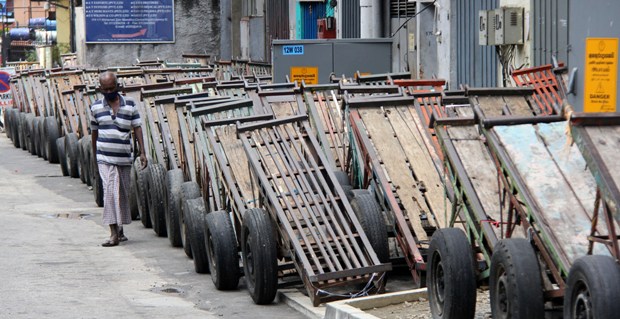Foreign reserves depleting, inflow down to a trickle: How COVID-19 forced Sri Lanka into a food emergency
By D. P. Satish
Shirani Senanayake is trying to send money to the US for her only daughter’s education, who is studying for a masters degree in economics at a New York university. Her daughter needs the money immediately for the current academic session, but Senanayake has not been able to send the US $3,000 from her bank in Colombo. The bank has put her on a waitlist as there is a long queue. The exasperated mother says she is now left with no other option, except to try informal routes to send the money so that her daughter’s studies are not disrupted in a faraway land.
Almost every bank in Sri Lanka is facing an acute shortage of foreign currencies while the government has put a ceiling on money that can be sent abroad. Every day, hundreds visit banks in hopes that they will get some US dollars for emergency needs.
The third wave of COVID-19 and the back-to-back lockdowns have put the island nation in a precarious situation. Its foreign reserves are depleting at an alarming rate and the inflow is a trickle compared to the outflow of cash.
The Gotabaya Rajapaksa-led government has introduced food emergency to contain spiralling inflation. The government has put severe restrictions on import of non-essential commodities such as motor vehicles, expensive tyres, flooring tiles, furniture, gadgets, some construction material among others. This has hit already crumbling businesses hard.
Sri Lanka has a dubious distinction. According to World Bank, it is the only upper middle-income group country in the entire South Asia. It has a 100% literacy rate and tops human development indices in other areas. The future was looking bright for Sri Lankans in January 2020. COVID-19 hit the world a month later and life for the country’s population turned upside down overnight.
Though the country managed the first wave of COVID-19 well, the second and third waves took a massive toll on the country’s economy and social life. The Delta variant has ravaged the country, with the latest victim being former foreign and finance minister Mangala Samaraweera.
With a modest population of 22 million, Sri Lanka is heavily dependent on imports. Most food products and other essentials are imported from neighbouring countries, including India. It does not have many manufacturing industries, and in this area, too, there is maximum import.
Sri Lanka is considered as one of the top 10 tourist destinations in the world and attracts over two million tourists a year. Though the tourism sector’s contribution to the gross domestic product is 5%, it employs over three million people and earns over US $4 billion in revenue, every year. The entire sector, however, is almost dead and tour operators are awaiting a miracle to rescue them.
“If the same situation continues for another six months, over 50% of the tourism industry will shut down making millions jobless. It is a scary scenario. It is a hard cash industry. Money flow has stopped completely,” said the owner of a leading hotel in Colombo.
Sri Lanka exports tea, cinnamon, spices, seafood products, gems and garments to the West earning over US $6 billion in foreign currencies, every year. The COVID-19 lockdown and weak consumer sentiments across the globe have resulted in low demand for these products. Both export and import businesses have taken a big hit.
The Sri Lankan Diaspora is another main source of income for the island nation, which sends home close to US $1.5 billion, every year. The global pandemic has impacted even the remittance, and experts estimate that there has been a drop of at least 25% this year. To tide over the crisis the country is facing, Central Bank of Sri Lanka (CBSL) has entered into a currency swap and line of credit with India, China and Bangladesh.
The food emergency imposed to contain inflation has led to hoarding and black-market activity, further aggravating the situation.
“We are in the solar business. We import panels from China and other countries. We can’t send money to foreign banks because of the currency crisis. Our business has taken a big hit. We are now exploring options of sending money from foreign accounts. It is really a chaotic situation here,” said a partner in the business.
The CBSL has authorized respective banks to manage foreign currencies, and exchange rate varies from bank to bank. The US dollar was selling at 230 Sri Lankan rupees on Friday, while the Indian rupee was selling at 3 Sri Lankan rupees.
“The CBSL seems to have abandoned its primary responsibilities. The banks are now functioning like private finance companies. This is really shocking,” said a businessman in export and import.
Despite everyday hardships, Sri Lankan people still manage to smile and are hopeful that it is a temporary setback for the country. “We are a resilient society. We have seen much worse in the past. In the 1970s, we had a severe food crisis, Marxist JVP-led violent movement, 30 years of brutal civil war that killed over one lakh people, the devastating tsunami of 2004 and the recent Easter bombings. We have emerged much stronger after every crisis. I am hopeful of a quick recovery. We will surely bounce back soon,” said Chandana Amaradasa, a tourism sector expert.
-D. P. Satish is a New Delhi based journalist with over 21 years’ experience, and keenly follows major political developments across the World. This article was originally featured on news18.com


